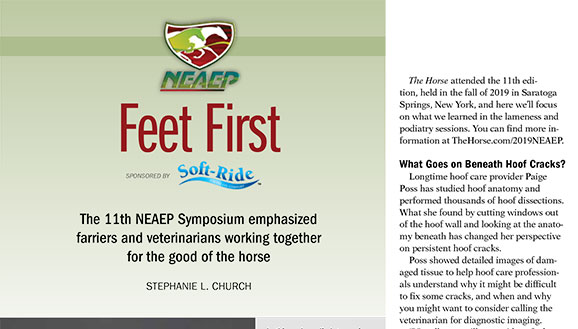
How to Support Horses With Acute or Chronic Laminitis
Researcher: Treating chronic laminitis will always be difficult, so prevention is key.
Laminitis (commonly called “founder”) affects an estimated 7-14% of the world’s equine population. It’s the inflammation of the tiny, interwoven lamellae that attach a horse’s hoof to the underlying coffin bone (third phalanx, or P3) and support the horse’s entire body weight. Anything that impacts the integrity of the lamellae, such as inflammation, weakens their hold. This causes the coffin bone to displace within the hoof capsule and move toward the ground. The condition is very painful and is often life-threatening to horses.
The same disease has several different causes, which include:

Researcher: Treating chronic laminitis will always be difficult, so prevention is key.

The 11th NEAEP symposium emphasized farriers and veterinarians working together for the good of the horse. Read our in-depth coverage in this free report, sponsored by Soft-Ride.

Something on the X rays looks a bit off—is it significant or of no consequence? It depends on what you find.

Does wrapping a horse’s lower legs in the winter aid circulation and keep them warm?

Researchers looked at donkeys’ unique hoof care needs. Here’s what they recommend.

What is a venogram, and how is it used to help diagnose laminitis?

After a horse has had a bout of laminitis, can she be brought up slowly on grass again? If so, how soon can this be done?

Here’s how to react if your horse consumes feed designed for another animal.

Can horses with PPID be turned out on pasture and have grass? It depends, one researcher says. Here’s why.

Australian researchers recently tested whether velagliflozin could help prevent laminitis in horses, and they say it’s showing promising results in early trials.

Laminitis is one of the most common diseases in horses, and it has many different causes. Find answers to listener questions on endocrine-related laminitis in horses with conditions such as PPID, equine metabolic syndrome, and insulin resistance. Sponsored by InsulinWise.

An acute laminitic episode is an emergency. Drs. Jane Manfredi and Teresa Burns discuss critical care of these cases.

Researchers aren’t sure why insulin dysregulation causes laminitis, but they do have some clues. Dr. Teresa Burns explains.

Dr. Teresa Burns describes what laminitis is and its relationship to endocrine diseases such as insulin resistance, equine metabolic syndrome, and PPID.

Dr. Jane Manfredi offers insight into how certain supplements might support horses at risk for endocrine-related laminitis.

Researchers and veterinarians around the world strive to learn more about the lamellae and have made scientific advances in laminitis diagnosis, treatment, and prevention over the past several years. Here’s what we know.
Stay on top of the most recent Horse Health news with
"*" indicates required fields